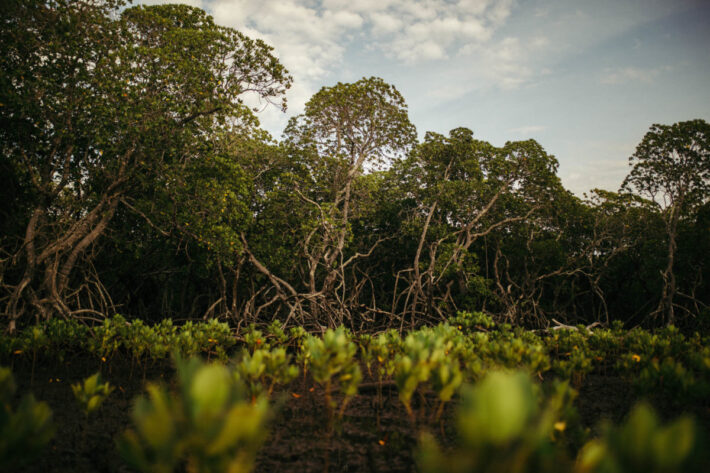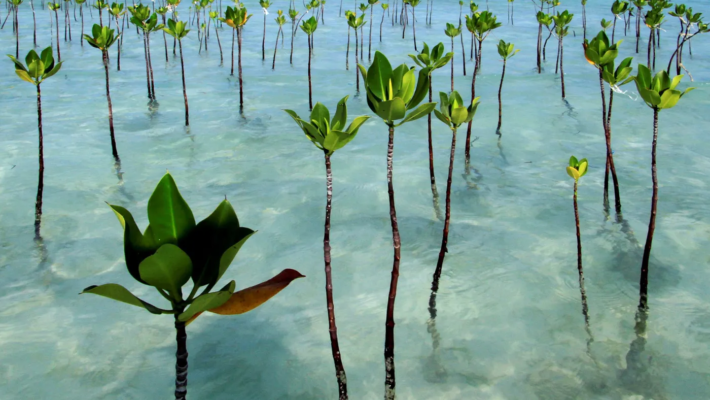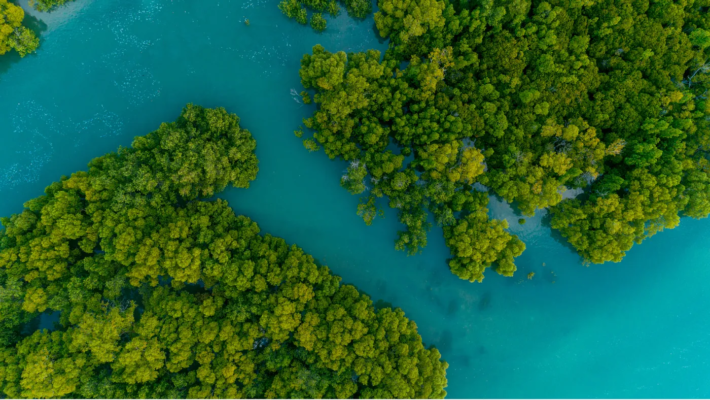Celebrating Mangroves: The Unsung Heroes in the Fight Against Climate Change

International Day for the Conservation of the Mangrove Ecosystem is upon us! Celebrated around the globe on July 26, this special designation was adopted by UNESCO in the General Conference of 2015 to raise awareness about the crucial mangrove forests and the tremendous impact these forests have on our planet.
Mangroves, with their unique adaptations and ecological functions, are vital coastal ecosystems. However, due to human activities and natural processes, these ecosystems have suffered degradation and loss in various regions across the planet.
The restoration of mangroves has emerged as a powerful tool to reverse these trends and restore the health of coastal ecosystems impacting land, sea and air.
What exactly is a mangrove forest?
A mangrove is a type of ecosystem characterized by salt-tolerant trees and shrubs that grow in the coastal intertidal zones of tropical and subtropical regions. These ecosystems are found in areas with a combination of saltwater and freshwater, such as estuaries, lagoons, and mudflats.
Mangroves have unique adaptations that allow them to survive in harsh coastal environments. Their roots are specially adapted to withstand tidal fluctuations, high salinity, and waterlogged conditions. Some species have stilt-like roots called pneumatophores that help them obtain oxygen in waterlogged soils. These adaptations make mangroves well-suited to protect coastlines from erosion, stabilize sediment, and provide habitats for various organisms.
Mangrove forests play a crucial role in the coastal ecosystem. They provide sheltered nursery grounds for many species of fish, crustaceans, and birds. The complex root systems of mangroves also serve as habitats for various invertebrates, reptiles, and mammals. Additionally, mangroves contribute to the overall biodiversity of the area and act as a buffer against storms and tidal surges.
These ecosystems are also valuable in terms of their ecological services. Mangroves filter pollutants, trap sediment, and help maintain water quality. They are carbon-rich environments that sequester significant amounts of carbon dioxide from the atmosphere, thereby mitigating climate change. Furthermore, mangroves are economically important as a source of timber, firewood, and various non-timber forest products for local communities.
Why are mangroves forests so important?
Coastal Protection: Mangroves act as a natural barrier against coastal erosion and storm damage. Their intricate root systems and dense vegetation help dissipate wave energy, reducing the impact of storms and protecting coastlines from erosion. This protection is especially crucial in areas prone to hurricanes and tidal surges.
Habitat and Biodiversity: Mangroves serve as critical habitats for a diverse range of species. They provide sheltered nursery grounds for numerous fish, crustaceans, and other marine organisms, supporting the reproduction and growth of commercially important species. Mangroves also offer feeding and nesting habitats for various birds, reptiles, and mammals, contributing to overall biodiversity in coastal areas.
Water Quality Improvement: Mangroves act as natural filters, trapping sediments, pollutants, and excess nutrients that may enter coastal waters from land. Their dense root systems and the accumulation of organic matter in the sediments help in the retention and removal of pollutants, improving water quality and reducing the impacts of runoff.
Carbon Sequestration: Mangroves are highly efficient at storing carbon dioxide (CO2) from the atmosphere. They capture and store significant amounts of carbon in their above-ground biomass, below-ground roots, and in the sediments. This makes mangroves valuable in mitigating climate change by sequestering carbon and reducing greenhouse gas emissions.
Studies have estimated that mangroves can store between 200 and 1,000 metric tons of carbon per hectare, depending on factors such as tree density and age. This makes mangrove forests one of the most efficient ecosystems for carbon sequestration on Earth. The carbon stored in mangrove biomass helps mitigate climate change by reducing greenhouse gas concentrations in the atmosphere.
Nutrient Cycling: Mangroves play a vital role in nutrient cycling within coastal ecosystems. They uptake nutrients from the surrounding water, trap organic matter in their root systems, and release nutrients back into the ecosystem through decomposition. This nutrient cycling helps support productivity and sustains the overall health of the coastal ecosystem.
Erosion Control and Sediment Stabilization: The complex root systems of mangroves help stabilize sediments and prevent their erosion. The roots trap and bind sediment particles, reducing sediment runoff into coastal waters and maintaining the stability of the shoreline.
Climate Resilience: Mangroves help increase the resilience of coastal areas to the impacts of climate change. Their protective functions, such as coastal buffering and storm surge reduction, contribute to the adaptability of coastal communities and ecosystems in the face of rising sea levels and increased frequency of extreme weather events.
Overall, mangroves provide a wide range of ecological services that are vital for the health of coastal environments, biodiversity conservation, climate regulation, and the well-being of coastal communities.
Reforestation through RESTORE
In our pursuit of accountability, traceability, and long-term sustainability in mangrove reforestation, we’ve forged partnerships with verified conservation projects. Together, we’ve established a vibrant local community on Kenya’s coast, empowering them with resources, infrastructure, and training to become true stewards of their native eco-systems. Aligned with the U.N.’s sustainability goals, our on-the-ground operations leverage satellite technology and blockchain security, empowering locals to plant, maintain, and track progress while providing essential environmental and social metrics. Through real-time documentation, we secure the data required to tackle challenges surrounding the impact of these vital ecological endeavors.
We extend heartfelt gratitude to our esteemed partners, Turtle Bay Conservation Group and COBEC, for their unwavering support and commitment to our mangrove initiatives. Their collaboration has been instrumental in driving forward our mission to restore and preserve our planet’s invaluable mangrove ecosystems. With their contributions and shared dedication, we are empowered to make a tangible difference in safeguarding these vital habitats for the benefit of current and future generations. Together, we stand united in our collective effort to protect and cherish our natural world.




